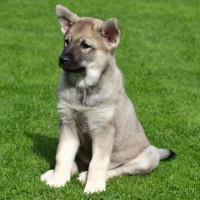Appearance of the Miniature Pinschelkhound
|
| Miniature Pinschelkhounds can vary considerably in appearance and size, depending on the strength of their parent's genetics. They often take more after one parent than the other. They may have the thick, dense coat and wolf-like face of the Norwegian Elkhound Gray, or they look very elegant and athletic, displaying the black and tan color combination and short coat of the Miniature Pinscher. The face is often very expressive, with large, round eyes, erect ears and a long, pointed muzzle whose teeth meet in a scissor bite. A well-proportioned body supported by strong legs is a distinctive feature, as is the tail, which can be fluffy and curled over the back, or it can be straight and high. The Miniature Pinschelkhound can often resemble a small Norwegian Elkhound Gray or a large dwarf Pinscher. But whatever its size, this dog's grace and beauty are hard to ignore. |
Temperament of the Miniature Pinschelkhound
|
| Although temperament varies between dogs of the same breed, the Miniature Pinschelkhound is generally a proud, loyal but feisty dog, and can be an independent thinker, which means they can be a little stubborn. But on the other hand, they are affectionate, devoted and protective of their human family. Although these dogs are highly intelligent, they can be a little stubborn and need a firm hand to train. They can be trainable barkers, but keep this in mind if you're an apartment dweller. This dog responds best to an owner who is the pack leader, who is fair, but firm. Letting this dog be the boss is detrimental to the dog and the relationship it will have with the family. The Miniature Pinschelkhound is a dog with a sense of humor, they love to play and they love to cuddle. These dogs are also very empathetic, they know if you're sad and will respond by snuggling up to you and resting their head in your lap to comfort you. Attractive in appearance and nature, these dogs can challenge the inexperienced owner, but are well worth the effort for a pet with lots of character that will fit in perfectly with the family. |
Needs and activities of the Miniature Pinschelkhound
|
| Miniature Pinschelkhounds require daily exercise in the form of walks or free play. They'll be happy to run alongside you or accompany you on a walk around town. This will help socialize your dog and enable him to become a well-rounded dog with good manners. If they've inherited the dense coat of the Norwegian Elkhound Gray, they may find it difficult to cope with hot temperatures. Make sure you don't over-exert them during the heat of the day. The Miniature Pinschelkhound will love a yard, and beyond, to explore, and can be quite the escape artist, so make sure your fence is very secure. These dogs love to play but have an independent sequence, so you won't always be able to retrieve the ball and will have to chase them for it. |
Maintenance of the Miniature Pinschelkhound
|
| The care of your Miniature Pinschelkhound may vary according to the coat the dog inherits. If the coat is short and tight, like the Miniature Pinscher's parents, all he'll need is a weekly brushing, an occasional bath and he'll be ready to go. However, if he inherits the thick, dense coat of the Norwegian Elkhound Gray, he'll need frequent brushing, often requiring daily attention to avoid matting. Whatever the type of coat, always use a special dog formula for bathing: a mild dog shampoo is recommended. Other areas to check are the ears to make sure they're clean, the eye area and the toenails to see if they need a quick clip. Brushing your dog's teeth is an important part of pet care, it will keep teeth healthy and oral hygiene standards high. |









 English (United Kingdom)
English (United Kingdom)